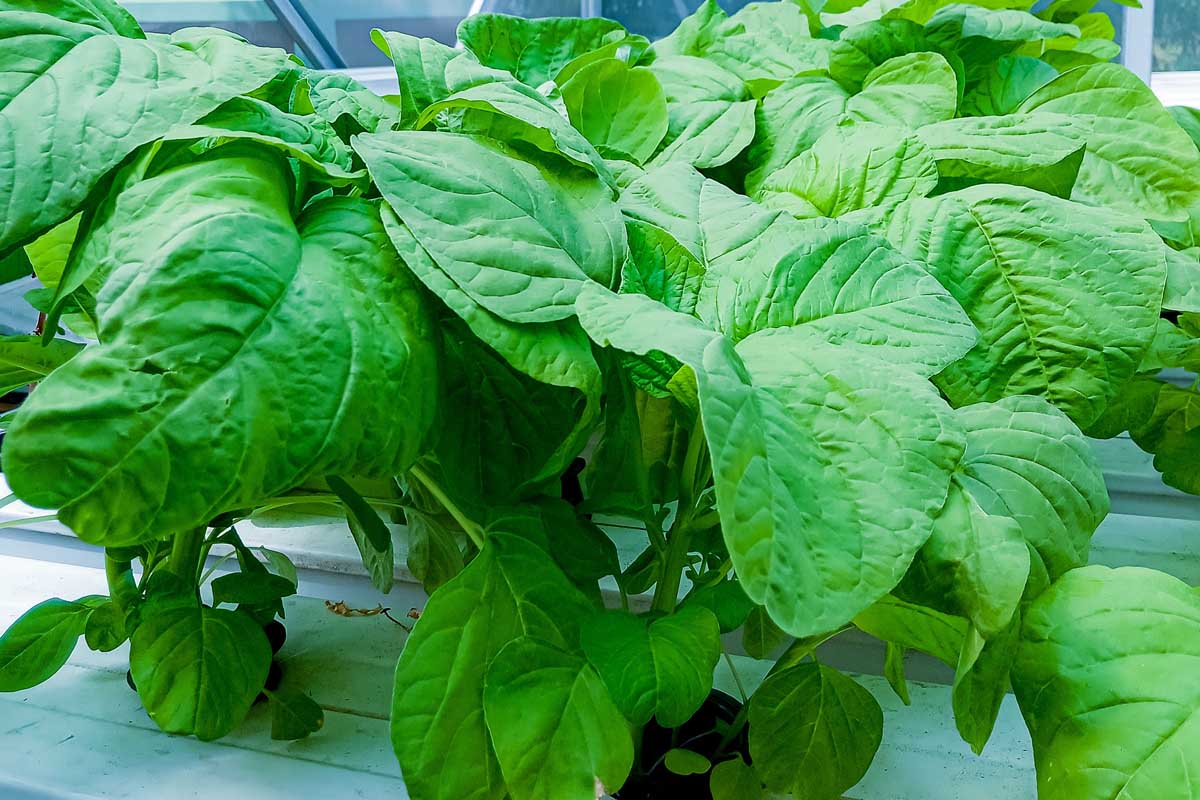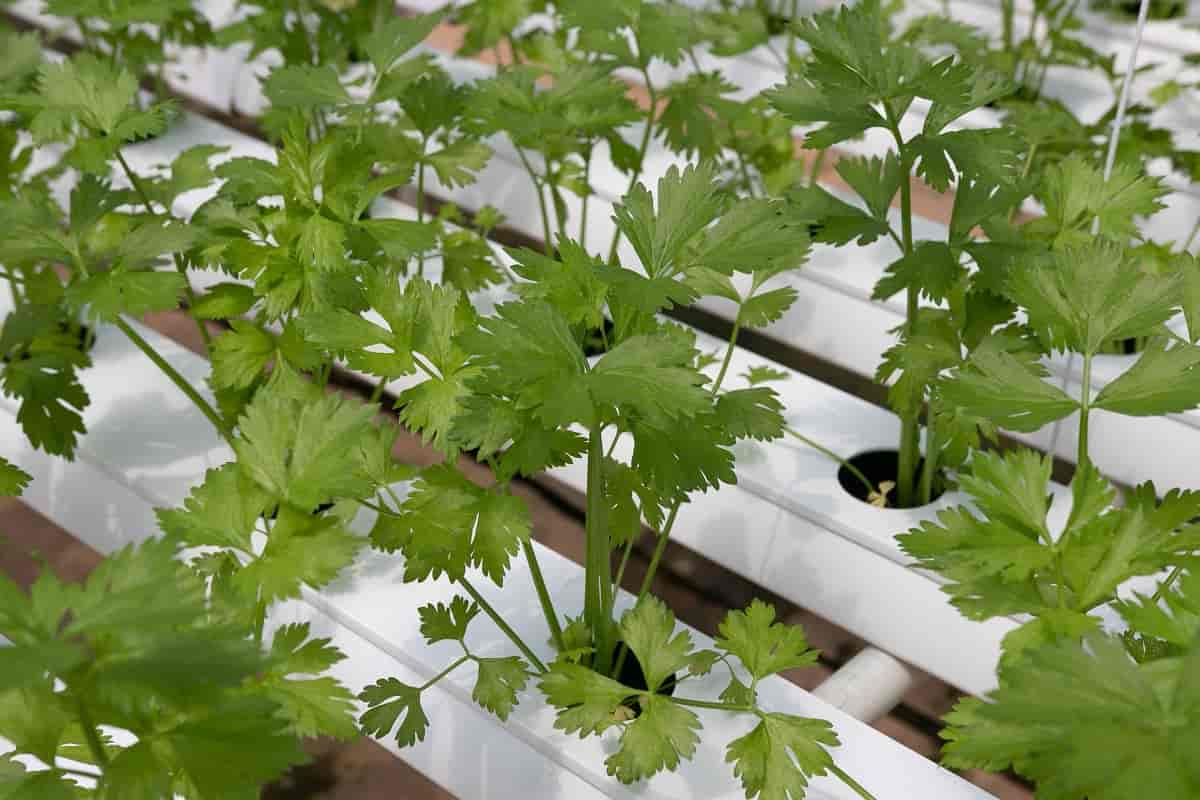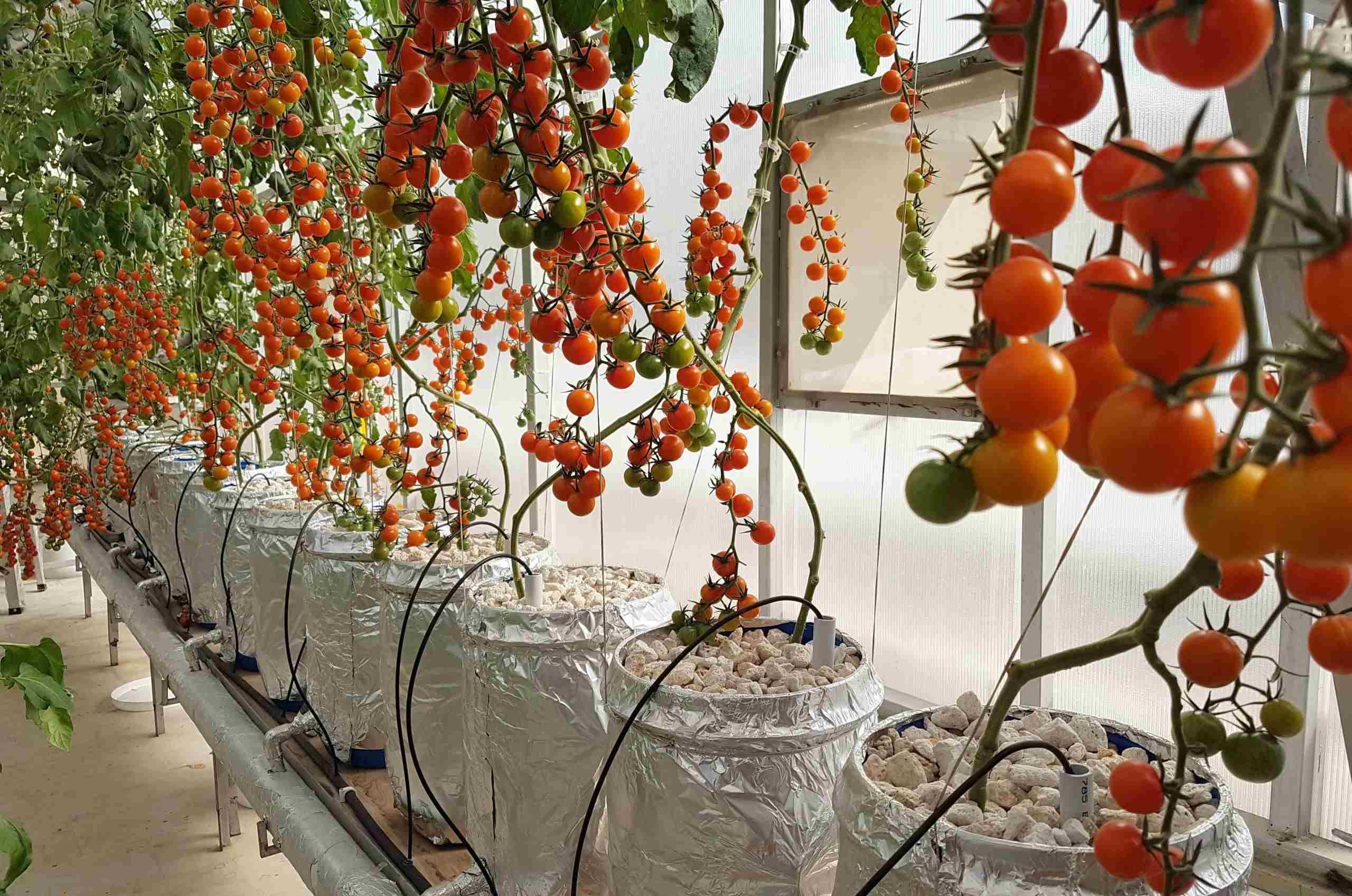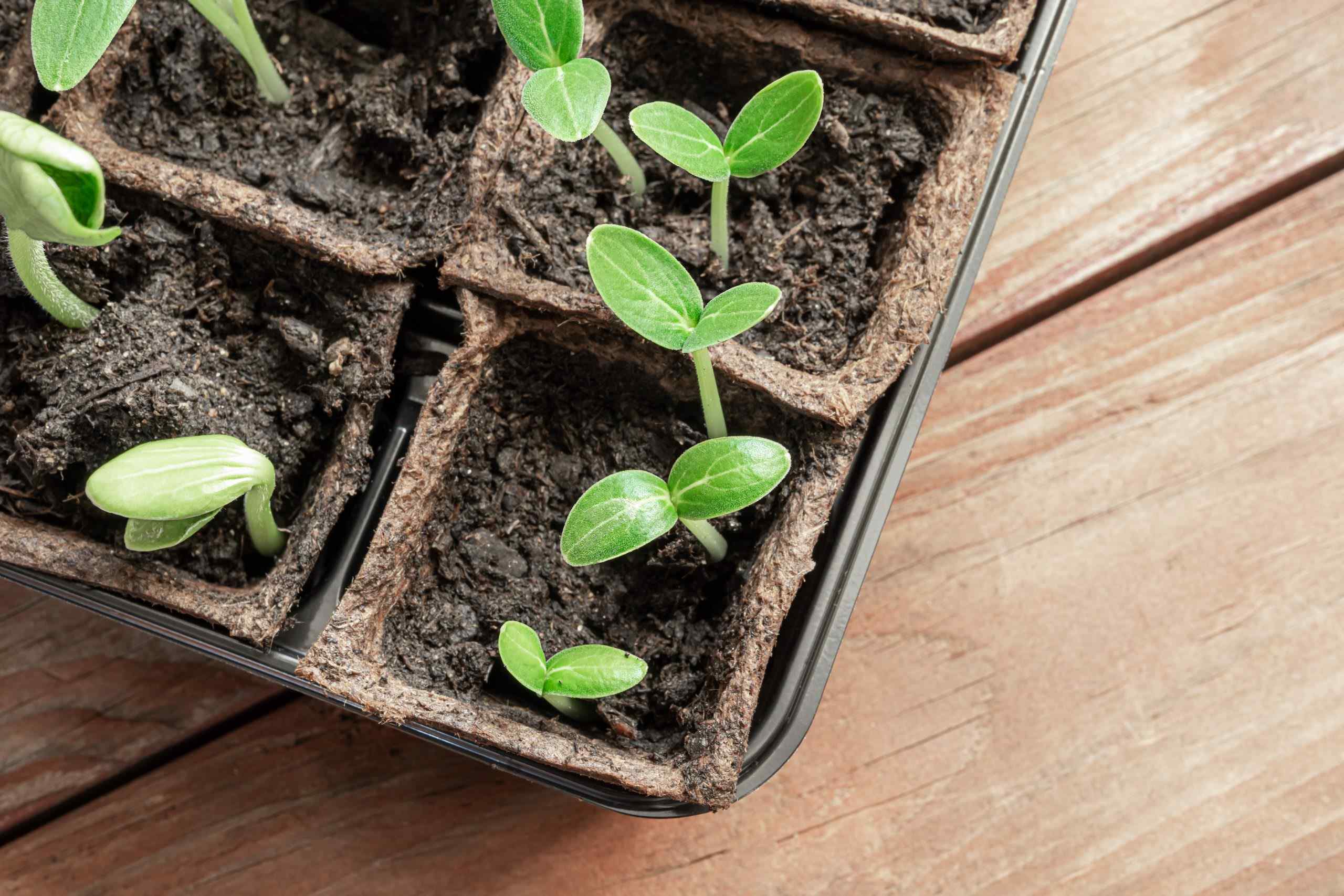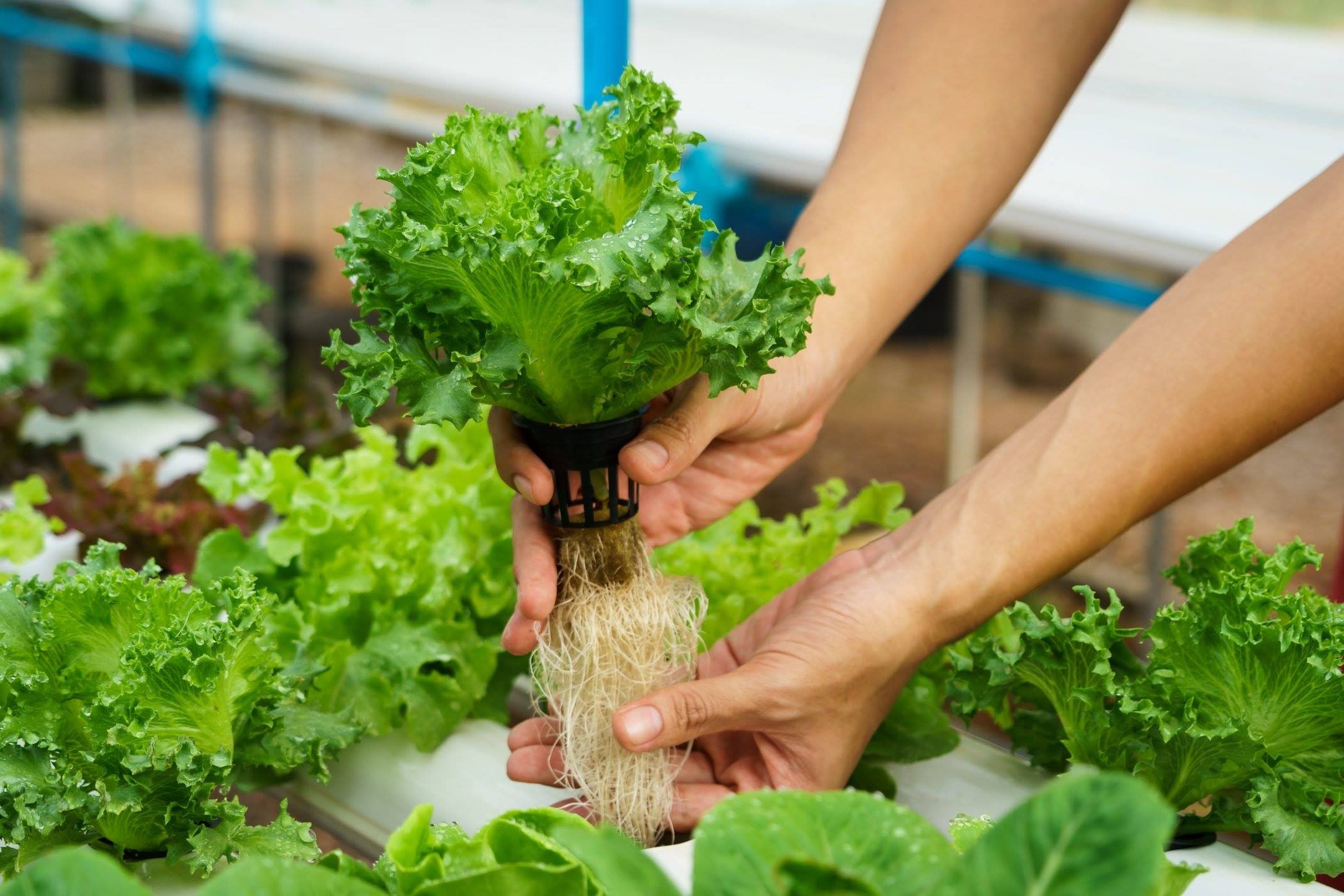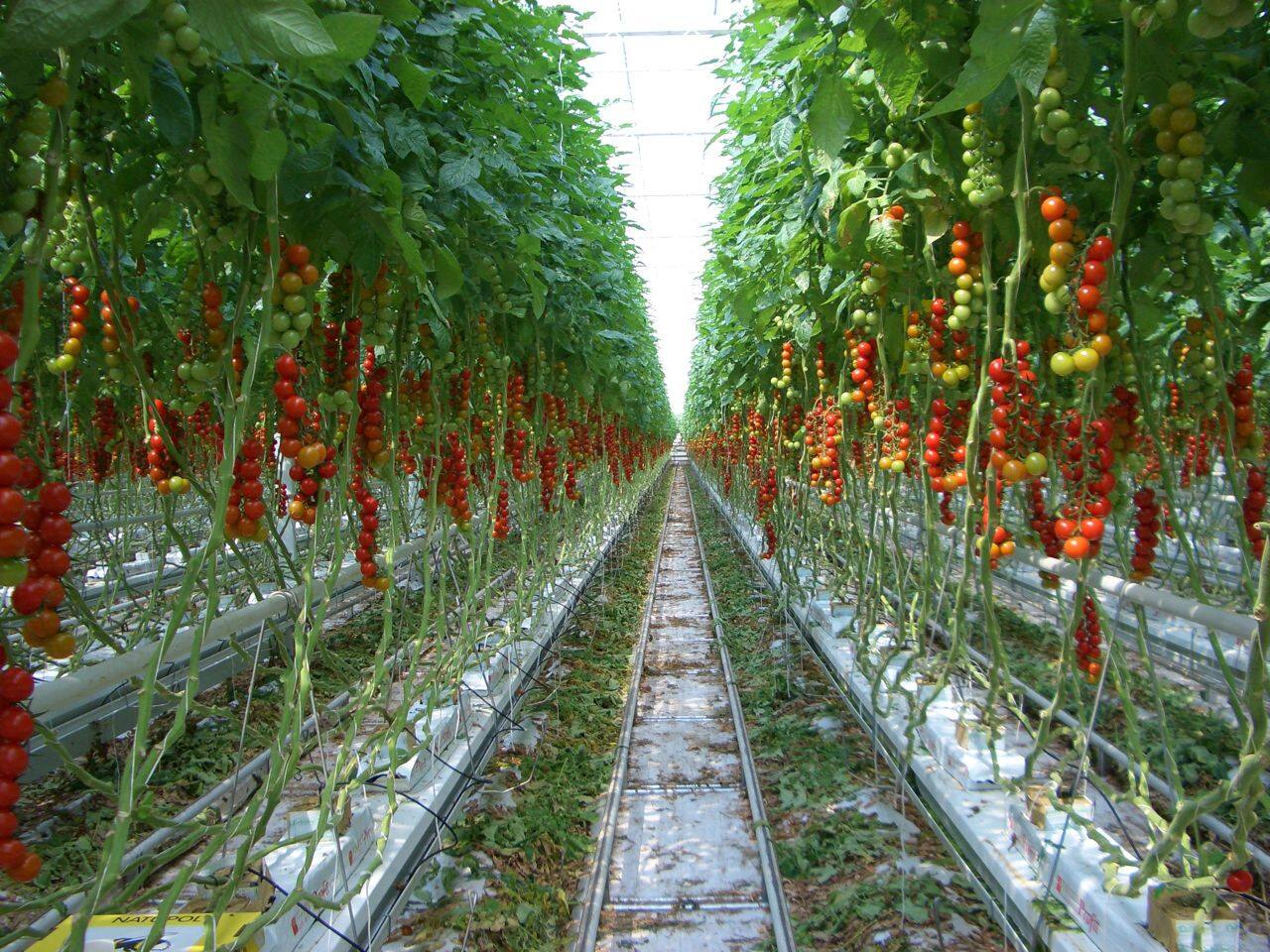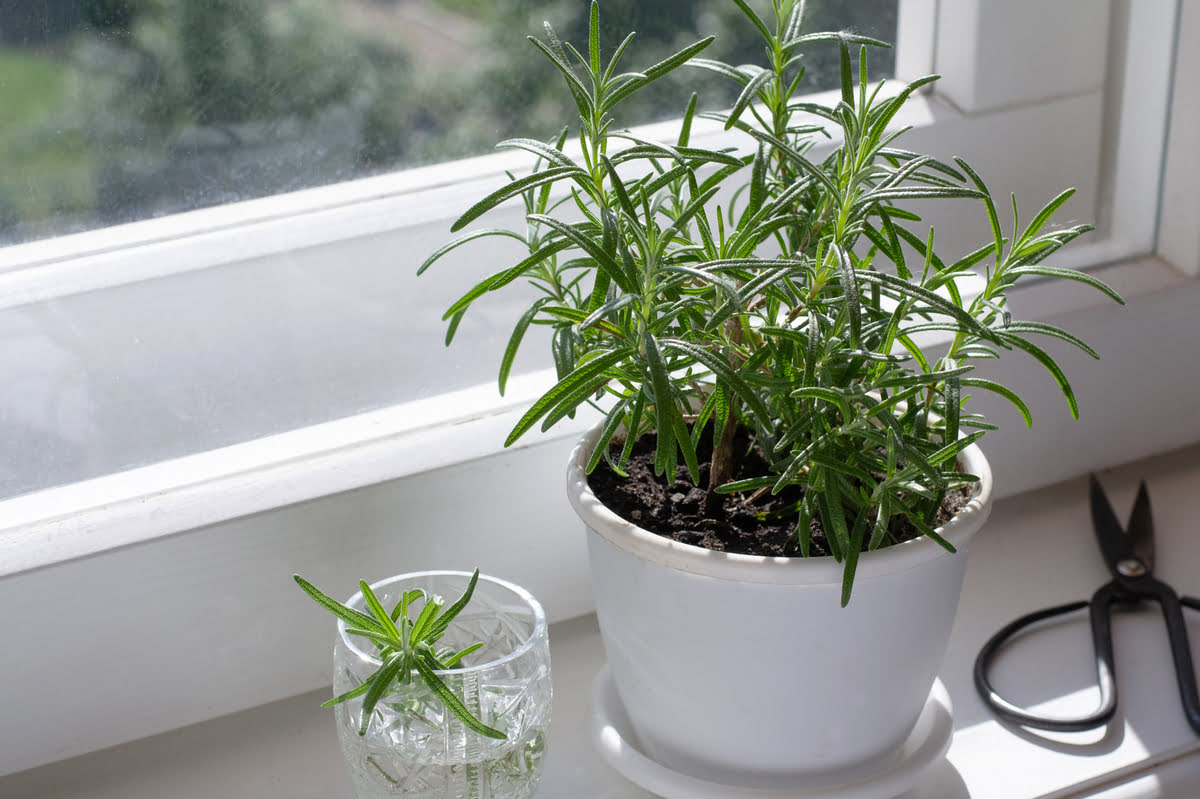Home>Gardening Tips and Tricks>Maximizing Yield>How Long To Grow Lettuce In Hydroponics
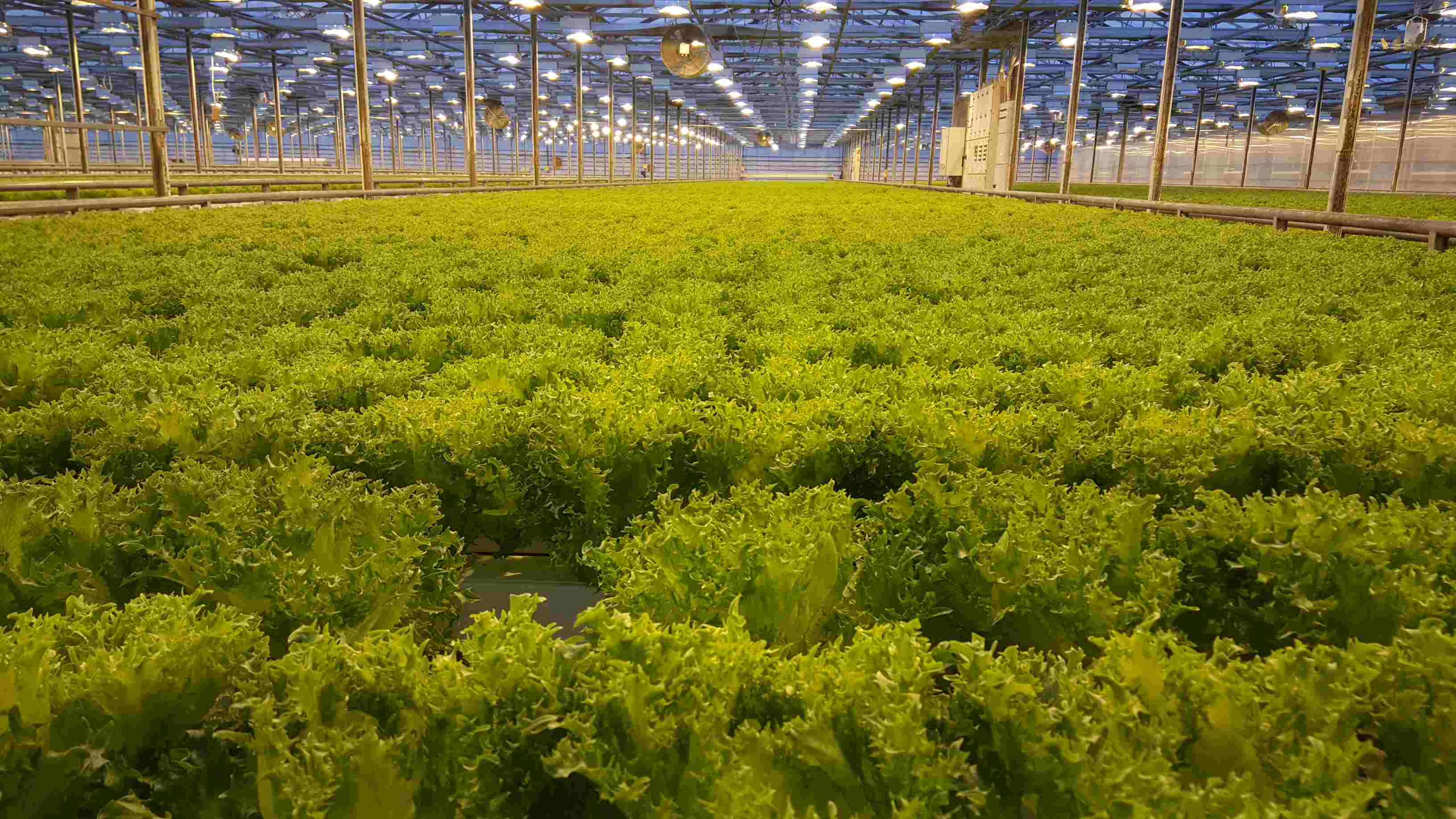

Maximizing Yield
How Long To Grow Lettuce In Hydroponics
Modified: January 22, 2024
Find out how long it takes to grow lettuce in hydroponics and learn the best techniques for maximizing yield.
(Many of the links in this article redirect to a specific reviewed product. Your purchase of these products through affiliate links helps to generate commission for Chicagolandgardening.com, at no extra cost. Learn more)
Table of Contents
- Introduction
- Benefits of Growing Lettuce in Hydroponics
- Factors Affecting Lettuce Growth in Hydroponics
- Recommended Varieties of Lettuce for Hydroponics
- Ideal Growing Conditions for Lettuce in Hydroponics
- Nutrient Requirements for Lettuce in Hydroponics
- Managing pH and EC Levels for Lettuce in Hydroponics
- Seed Starting and Transplantation in Hydroponic Lettuce Cultivation
- Light and Temperature Requirements for Hydroponic Lettuce
- Common Pests and Diseases in Hydroponic Lettuce Production
- Harvesting and Yield Expectations in Hydroponic Lettuce Cultivation
- Conclusion
Introduction
Growing lettuce in hydroponics is becoming increasingly popular among farmers and gardening enthusiasts. Hydroponics is a method of cultivating plants without the use of soil, instead relying on a nutrient-rich water solution to provide all the necessary elements for growth. This innovative approach offers several benefits over traditional soil-based cultivation, including faster growth, higher yields, and better control over environmental factors.
Lettuce, a leafy green vegetable and a staple in many cuisines, is particularly well-suited for hydroponic cultivation due to its shallow root system and rapid growth rate. By providing the ideal growing conditions and nutrient balance, hydroponics allows lettuce plants to thrive and produce high-quality, flavorful leaves.
One of the main advantages of growing lettuce in hydroponics is the reduced space requirement. As the plants do not need to spread their roots in search of nutrients, they can be grown in a more compact and efficient manner. This makes hydroponics a great option for urban gardeners or those with limited gardening space.
Furthermore, hydroponics provides better control over water and nutrient delivery. The nutrient solution can be precisely tailored to meet the specific needs of lettuce plants at different stages of growth. This ensures that the plants receive the optimal balance of essential elements, resulting in healthier and more vigorous growth.
In addition, hydroponics allows for year-round cultivation of lettuce, regardless of the external climate. By creating a controlled environment, growers can maintain the ideal temperature, humidity, and light levels, which means they are not limited to seasonal constraints. This provides a consistent supply of fresh, homegrown lettuce throughout the year.
Overall, growing lettuce in hydroponics offers numerous advantages, including increased yields, faster growth, better nutrient control, and year-round cultivation. In the following sections, we will explore the essential factors that affect lettuce growth in hydroponics, recommended lettuce varieties, ideal growing conditions, nutrient requirements, seed starting, light and temperature needs, common pests and diseases, harvesting techniques, and yield expectations. By mastering these techniques, you can maximize your lettuce production and enjoy a bountiful harvest.
Benefits of Growing Lettuce in Hydroponics
Growing lettuce in hydroponics offers several significant benefits that make it an attractive option for both commercial farmers and home gardeners. Let’s explore some of the key advantages of cultivating lettuce in a hydroponic system.
- Increased Yields: One of the primary benefits of hydroponics is the potential for higher yields compared to traditional soil-based methods. In a well-maintained hydroponic system, lettuce plants can grow faster and produce more abundant foliage, resulting in a greater harvest.
- Year-Round Cultivation: Hydroponics allows for year-round lettuce cultivation, irrespective of external environmental conditions. By creating an artificial growing environment, growers can ensure that their lettuce plants receive the optimal temperature, humidity, and light levels necessary for continuous growth and harvest.
- Water Efficiency: Hydroponics is known for its water efficiency. Unlike soil-based systems, where water can be lost through evaporation or runoff, a hydroponic system recirculates and reuses the water. This not only conserves water but also reduces the risk of nutrient leaching and minimizes the overall environmental impact.
- Space Utilization: Hydroponic systems can be designed for vertical or stacked cultivation, allowing growers to maximize space utilization. By utilizing vertical space, more plants can be grown within a smaller footprint, making hydroponics an ideal choice for urban or small-scale farming.
- No Weeding: Hydroponics eliminates the need for weeding, as there is no soil involved. This saves growers significant time and effort in maintaining weed-free growing beds, allowing them to focus more on other critical aspects of plant care.
- Pest and Disease Control: With hydroponics, growers have better control over pests and diseases compared to traditional soil-based cultivation. By eliminating the soil, the risk of soil-borne pests and diseases is greatly reduced. Additionally, the controlled environment of a hydroponic system makes it easier to monitor and manage any potential pest or disease outbreaks.
These are just a few of the many advantages of growing lettuce in hydroponics. The controlled environment, water efficiency, increased yields, and year-round cultivation possibilities make hydroponics an appealing choice for lettuce growers. In the following sections, we will delve deeper into the essential factors for successfully growing lettuce in a hydroponic system.
Factors Affecting Lettuce Growth in Hydroponics
While growing lettuce in hydroponics offers several advantages, it’s essential to understand the factors that can influence the growth and development of the plants. By carefully managing these factors, growers can optimize lettuce production and achieve the best possible results. Let’s explore some of the key factors affecting lettuce growth in a hydroponic system.
- Light: Light is a crucial factor for lettuce growth. Lack of proper lighting can result in spindly, elongated plants with weak foliage. On the other hand, excessive light levels can cause leaf burn and other stress-related issues. Providing the right amount and duration of light is essential for promoting healthy lettuce growth.
- Temperature: Lettuce thrives in cool temperatures and prefers a range between 15 to 20 degrees Celsius. High temperatures can lead to bolting (premature flowering) and bitter-tasting leaves, while excessively low temperatures can cause slow growth and reduced productivity. Maintaining the ideal temperature is crucial for optimal lettuce growth.
- Humidity: Lettuce prefers moderate humidity levels, around 50 to 70 percent. High humidity can increase the risk of fungal diseases, such as powdery mildew, while low humidity can lead to dehydration and stunted growth. Maintaining proper humidity levels within the hydroponic growing area is important for healthy plant development.
- Air Circulation: Adequate air circulation is essential to prevent the buildup of stale, stagnant air around the lettuce plants. Good airflow helps in reducing the chances of fungal diseases and also facilitates the exchange of carbon dioxide and oxygen, vital for photosynthesis and respiration processes.
- Water Quality: The quality of water used in a hydroponic system can significantly impact lettuce growth. It’s essential to ensure that the water is free from contaminants, chlorine, and excessive minerals that can hinder nutrient absorption. Monitoring and maintaining water quality is crucial for providing a healthy growing environment for the lettuce plants.
- Nutrient Balance: Hydroponics requires a well-balanced nutrient solution to provide all the essential elements required for lettuce growth. Ensuring the right concentration and balance of macronutrients (nitrogen, phosphorus, and potassium) and micronutrients is critical for promoting robust root development, leaf growth, and overall plant health.
- pH and EC Levels: Maintaining proper pH and Electrical Conductivity (EC) levels in the nutrient solution is vital for optimal nutrient uptake by the lettuce plants. The recommended pH range for lettuce is typically between 5.5 to 6.5, while the EC levels should be monitored and adjusted according to the growth stage of the plants.
By carefully managing these factors, growers can create an ideal environment for lettuce growth in a hydroponic system. Understanding the significance of light, temperature, humidity, air circulation, water quality, nutrient balance, and pH and EC levels is key to cultivating healthy, vigorous lettuce plants. In the following sections, we will delve into more details on each of these factors and explore strategies for optimizing lettuce growth in hydroponics.
Recommended Varieties of Lettuce for Hydroponics
When it comes to hydroponic lettuce cultivation, selecting the right variety is essential for ensuring successful growth and a bountiful harvest. There are numerous lettuce varieties available, each with its own unique characteristics and growth requirements. Here are some recommended varieties that are well-suited for hydroponics:
- Butterhead Lettuce: Butterhead lettuce, such as ‘Bibb’ or ‘Boston’, is a popular choice for hydroponics. It has tender, buttery leaves that form small, loose heads. These varieties are relatively easy to grow and have a mild flavor, making them a favorite for salads and sandwiches.
- Romaine Lettuce: Romaine lettuce, like ‘Cos’ or ‘Little Gem’, is known for its long, crisp leaves and upright growth habit. It has a slightly stronger flavor than butterhead lettuce and is often used in Caesar salads or as a lettuce wrap. Romaine lettuce performs well in hydroponic systems and can tolerate higher temperatures compared to other varieties.
- Leaf Lettuce: Leaf lettuce, such as ‘Red Salad Bowl’ or ‘Green Oakleaf’, is a popular choice for hydroponics due to its loose, leafy growth habit. It comes in various color options and offers a range of flavors from mild to slightly peppery. Leaf lettuce is easy to harvest by simply cutting off the outer leaves, allowing the plant to continue growing.
- Iceberg Lettuce: Iceberg lettuce, also known as crisphead lettuce, is a classic choice for salads. While it can be more challenging to grow in hydroponics due to its longer maturity time, newer compact varieties, like ‘Salad Time’ or ‘Great Lakes’, have been developed specifically for hydroponic cultivation. These varieties produce smaller heads and have a crisp texture.
- Microgreens: Microgreens are young, tender lettuce plants harvested at the cotyledon or first leaf stage. They are packed with flavor and are a popular choice for garnishing salads, sandwiches, and other dishes. Microgreens can be grown from a variety of lettuce seeds, such as green leaf, red leaf, or a mix of different varieties.
When selecting lettuce varieties for hydroponics, consider factors such as growth habit, flavor, color, maturity time, and suitability for the desired application (e.g., salads, sandwiches, microgreens). It’s also worth experimenting with different varieties to find the ones that perform best in your specific hydroponic system and growing conditions.
It’s important to note that lettuce varieties optimized for hydroponic cultivation may differ from those commonly grown in soil-based systems. Look for varieties specifically recommended for hydroponics or seek advice from local experts or hydroponic suppliers to find the best lettuce varieties for your hydroponic setup.
By selecting the right lettuce varieties, you can ensure successful growth and enjoy a diverse range of flavors and textures in your hydroponically-grown lettuce. In the next sections, we will explore the ideal growing conditions and nutrient requirements to optimize the growth of lettuce in hydroponics.
Ideal Growing Conditions for Lettuce in Hydroponics
Creating the ideal growing conditions is crucial for promoting healthy and vigorous growth of lettuce in a hydroponic system. By optimizing environmental factors such as temperature, humidity, light, and air circulation, growers can ensure optimal conditions for lettuce plants to thrive. Let’s explore the ideal growing conditions for lettuce in hydroponics:
- Temperature: Lettuce prefers cool temperatures for optimal growth. The ideal temperature range for lettuce in hydroponics is around 15 to 20 degrees Celsius (59 to 68 degrees Fahrenheit). Maintaining a consistent temperature within this range helps to avoid issues such as bolting and ensures proper leaf development.
- Humidity: Lettuce prefers moderate humidity levels, typically around 50 to 70 percent. Higher humidity can increase the risk of fungal diseases, such as powdery mildew, while low humidity can lead to dehydration and stunted growth. Using a humidifier or ensuring proper ventilation can help maintain the ideal humidity level.
- Light: Light is essential for lettuce growth and plays a significant role in photosynthesis. Lettuce requires around 12 to 16 hours of light per day for optimal growth. Using full-spectrum grow lights, such as LED or fluorescent lights, can provide the necessary light intensity and spectrum required for healthy lettuce growth. Position the lights at an appropriate distance from the plants to ensure even coverage.
- Air Circulation: Good air circulation is crucial for lettuce plants in hydroponics. It helps to prevent the buildup of stale air, reduces the risk of fungal diseases, and ensures an adequate exchange of carbon dioxide and oxygen. Use fans or natural ventilation to keep air moving around the plants, making sure not to create excessive drafts.
Water and Nutrient Solution: Lettuce in hydroponics requires a constant supply of a well-balanced nutrient solution. The water temperature should be maintained within the range of 18 to 22 degrees Celsius (64 to 72 degrees Fahrenheit) to avoid stress on the roots. Regular monitoring of the nutrient levels and adjusting the solution as necessary will help ensure that the plants have access to the necessary nutrients for healthy growth. - pH and EC Levels: Maintaining the proper pH and Electrical Conductivity (EC) levels of the nutrient solution is crucial for optimal nutrient uptake by the lettuce plants. The recommended pH range for lettuce is typically between 5.5 to 6.5. Monitoring and adjusting the pH and EC levels of the nutrient solution regularly will help ensure that the plants receive the right balance of nutrients.
- Growing Medium: In hydroponics, the growing medium provides support to the roots and helps with nutrient and moisture retention. Commonly used growing mediums for lettuce in hydroponics include perlite, vermiculite, coconut coir, or rockwool cubes. Choose a growing medium that allows for good root aeration and water drainage while retaining enough moisture for the plants.
By creating the ideal growing conditions, growers can provide a favorable environment for lettuce plants to thrive in a hydroponic system. Maintaining the right temperature, humidity, light, air circulation, water and nutrient solution, pH and EC levels, and choosing an appropriate growing medium will help ensure healthy and productive lettuce plants. In the following sections, we will delve deeper into the nutrient requirements and management of pH and EC levels for optimal lettuce growth in hydroponics.
Nutrient Requirements for Lettuce in Hydroponics
Providing the right balance of nutrients is crucial for healthy and vigorous growth of lettuce in a hydroponic system. Unlike traditional soil-based cultivation, where plants can extract nutrients from the soil, hydroponic lettuce relies entirely on the nutrient solution for its nutritional needs. Understanding the nutrient requirements and maintaining the optimal nutrient balance is essential. Let’s explore the key nutrients and their roles in lettuce growth:
- Nitrogen (N): Nitrogen is an essential macronutrient for lettuce growth, responsible for vegetative development and leaf production. It helps in building proteins, enzymes, and chlorophyll, which are vital for photosynthesis and overall plant health.
- Phosphorus (P): Phosphorus is necessary for root development, energy transfer, and flower and fruit production in lettuce plants. It aids in nutrient absorption and plays a significant role in DNA and cell membrane formation.
- Potassium (K): Potassium is involved in various physiological processes in lettuce, such as water regulation, enzyme activation, and disease resistance. It contributes to overall plant vigor, root growth, and quality of leaves.
- Calcium (Ca): Calcium is essential for cell wall development and growth. It strengthens cell structure, promotes healthy root development, and enhances disease resistance in lettuce plants.
- Magnesium (Mg): Magnesium is a vital component of chlorophyll, the pigment responsible for photosynthesis. It plays a crucial role in energy production, nutrient absorption, and enzyme activation in lettuce plants.
- Micronutrients: Lettuce also requires various micronutrients, albeit in smaller quantities. These include iron (Fe), manganese (Mn), zinc (Zn), copper (Cu), molybdenum (Mo), boron (B), and chlorine (Cl). Micronutrients are essential for enzyme activity, chlorophyll synthesis, and overall plant health.
In a hydroponic system, the nutrient solution must be carefully formulated to provide the necessary macronutrients and micronutrients to meet the lettuce plant’s requirements at different growth stages. The nutrient solution can be prepared using commercially available hydroponic nutrient mixes or by customizing the formulation based on the specific needs of the lettuce crop.
Monitoring the electrical conductivity (EC) and pH of the nutrient solution is crucial to ensure optimal nutrient uptake by the lettuce plants. The EC level indicates the concentration of dissolved salts in the nutrient solution, while the pH level affects nutrient availability. Regularly testing and adjusting the nutrient solution’s EC and pH levels based on the plant’s growth stage and the manufacturer’s recommendations will help maintain a suitable nutrient balance.
It’s important to note that nutrient requirements can vary between lettuce varieties and growth stages. Additionally, factors such as water quality, growing medium, temperature, and light intensity can influence the nutrient uptake and requirements of the plants. Regular observation, monitoring, and adjustment of the nutrient solution based on plant health and growth indicators will help ensure optimal nutrition for lettuce plants in hydroponics.
In the next sections, we will explore the management of pH and EC levels in more detail, as well as techniques for seed starting and transplantation in hydroponic lettuce cultivation.
Managing pH and EC Levels for Lettuce in Hydroponics
Maintaining proper pH and Electrical Conductivity (EC) levels in the nutrient solution is crucial for the optimal growth and nutrient absorption of lettuce in a hydroponic system. pH refers to the acidity or alkalinity of the solution, while EC measures the concentration of dissolved salts. Let’s explore the importance of managing pH and EC levels and how to ensure optimal conditions for lettuce growth:
pH Levels:
The pH level of the nutrient solution affects nutrient availability to the lettuce plants. Most lettuce varieties grow well in a pH range of 5.5 to 6.5. If the pH deviates from this range, nutrient uptake can be affected, leading to nutrient deficiencies or toxicities. Regularly monitoring the pH level is essential, as it can fluctuate over time due to plant uptake and changes in the nutrient solution. Adjustments can be made using pH-up or pH-down solutions to bring the pH back to the optimal range.
Electrical Conductivity (EC) Levels:
The EC level of the nutrient solution is a measure of its concentration of dissolved salts, indicating its nutrient strength. Monitoring and adjusting the EC levels is key to maintaining a balanced nutrient solution. Young lettuce plants generally require lower EC levels, while more mature plants have higher nutrient demands. The EC levels can be adjusted by diluting or adding nutrients to the solution, ensuring that it meets the specific requirements of the lettuce plants at different growth stages.
Monitoring and Adjustment:
Regular monitoring of the pH and EC levels is crucial in hydroponic lettuce production. This can be done using various tools, such as pH meters and EC meters. It’s recommended to check the levels daily or at least a few times per week. If the pH or EC deviates significantly from the optimal range, adjustments should be made promptly to avoid nutrient imbalances or deficiencies.
Techniques for Adjustment:
To adjust the pH level, pH-up or pH-down solutions can be used. These solutions are usually available commercially and can be added in small increments to gradually bring the pH to the desired range. It’s important to follow the manufacturer’s instructions and make adjustments slowly to avoid rapid pH swings, which can stress the lettuce plants.
Adjusting the EC level involves adding or diluting the nutrient solution. If the EC is too high, diluting the solution with fresh water can lower the concentration. Conversely, if the EC is too low, adding more nutrients to the solution can increase the concentration. Care should be taken to make adjustments gradually and monitor the EC level closely to achieve the desired nutrient strength.
By regularly monitoring and adjusting the pH and EC levels in the nutrient solution, growers can ensure optimal nutrient availability and absorption by the lettuce plants. This, in turn, promotes healthy growth, robust foliage, and higher yields.
In the following sections, we will explore techniques for seed starting and transplantation in hydroponic lettuce cultivation, as well as the light and temperature requirements for successful growth.
Seed Starting and Transplantation in Hydroponic Lettuce Cultivation
Seed starting and transplantation are crucial steps in hydroponic lettuce cultivation that require careful attention to ensure successful plant establishment and optimal growth. Let’s explore the techniques and considerations for seed starting and transplantation in hydroponics:
Seed Starting:
1. Selecting High-Quality Seeds: Start with high-quality lettuce seeds from a reputable source. Look for seeds that are known for their resistance to common diseases and pests, as well as their suitability for hydroponics.
2. Germination: Ensure optimal germination conditions by providing a warm and moist environment. Sow the seeds in a growing medium such as rockwool cubes or seedling trays filled with a soilless mix. Maintain a consistent temperature of around 20 to 25 degrees Celsius (68 to 77 degrees Fahrenheit) and keep the growing medium moist.
3. Light: After germination, provide adequate light to the seedlings. LED or fluorescent grow lights are suitable for this stage. Position the lights at an appropriate distance to prevent stretching and encourage robust growth.
Transplantation:
1. Growing Medium: Prior to transplanting, ensure that the growing medium is prepared and ready for the seedlings. This can include rockwool cubes, perlite, vermiculite, or coconut coir, depending on your preference and hydroponic system. The growing medium should provide adequate support to the roots and allow for proper water drainage and air circulation.
2. Timing: Transplant lettuce seedlings when they have developed a strong root system and have at least two to three true leaves. This usually occurs 10 to 14 days after germination, depending on the variety and growing conditions. Avoid transplanting seedlings that are too small or fragile, as they may struggle to establish themselves in the hydroponic system.
3. Transplantation Technique: Carefully remove the seedlings from the seedling trays or growing medium, being mindful not to damage the roots. Place the seedling into the prepared growing medium in the hydroponic system, ensuring that the roots are covered and supported. Gently firm the medium around the roots to provide stability.
4. Post-Transplant Care: After transplantation, provide optimal growing conditions to aid in plant establishment. Maintain the appropriate temperature, humidity, light, pH, and EC levels. Ensure that the nutrient solution is flowing properly through the system and reaching the roots. Monitor the plants for any signs of stress or nutrient deficiencies and make adjustments as necessary.
By following these seed starting and transplantation techniques, you can establish healthy, vigorous lettuce plants in your hydroponic system. Remember to provide proper care and attention to the seedlings during the initial stages to ensure successful plant establishment and to set the foundation for productive growth.
In the next sections, we will explore the light and temperature requirements for hydroponic lettuce cultivation, as well as common pests and diseases to be aware of and manage.
Light and Temperature Requirements for Hydroponic Lettuce
Providing the appropriate light and temperature conditions is crucial for the successful growth and development of lettuce in a hydroponic system. Light influences photosynthesis and overall plant growth, while temperature affects various physiological processes. Let’s explore the light and temperature requirements for hydroponic lettuce cultivation:
Light Requirements:
Lettuce plants require sufficient light for photosynthesis, which is essential for energy production and plant growth. Here are some key considerations for light requirements:
- Light Intensity: Lettuce performs well with a light intensity of around 100 to 200 micromoles per square meter per second (µmol/m²/s). Measure the light intensity using a light meter or use the manufacturer’s recommendations for your specific grow lights.
- Light Duration: Lettuce generally requires around 12 to 16 hours of light per day. This light duration allows for optimal photosynthesis and promotes healthy leaf development. Utilize timers to ensure consistent and appropriate lighting periods.
- Light Spectrum: Lettuce benefits from a full spectrum of light, including both blue and red wavelengths. LED grow lights are commonly used in hydroponic systems as they can provide the necessary light spectrum for vegetative growth and promote compact, lush lettuce foliage.
- Light Distance and Coverage: Position the grow lights at an appropriate distance from the lettuce plants to avoid light burn or excessive stretching. Each type of grow light has specific recommendations for the distance and coverage area, so follow the manufacturer’s guidelines for optimal light distribution.
Temperature Requirements:
Temperature plays a critical role in lettuce growth and development. Here are the key temperature considerations for hydroponic lettuce cultivation:
- Growing Temperature: Lettuce prefers cooler temperatures, with an ideal range of approximately 15 to 20 degrees Celsius (59 to 68 degrees Fahrenheit). This temperature range promotes optimal growth and prevents issues like bolting.
- Root Zone Temperature: Maintain a suitable root zone temperature as it greatly influences nutrient uptake and overall plant health. The recommended root zone temperature for lettuce is around 18 to 22 degrees Celsius (64 to 72 degrees Fahrenheit).
- Air Circulation: Good air circulation is important for temperature regulation and preventing temperature extremes. Use fans or natural ventilation to ensure proper airflow around the lettuce plants. Avoid direct drafts that may cause stress or damage to the plants.
- Nighttime Temperature: Lettuce benefits from slightly cooler temperatures during the night. Lowering the temperature by a few degrees during the nighttime promotes healthy growth and prevents bolting.
By providing the optimal light and temperature conditions, growers can ensure healthy and robust growth of lettuce in their hydroponic systems. Adequate light intensity, duration, spectrum, and coverage are important for photosynthesis and leaf development. Maintaining the appropriate growing and root zone temperatures, along with proper air circulation, creates an ideal environment for thriving lettuce plants.
In the next sections, we will explore common pests and diseases that can affect hydroponic lettuce and techniques for managing them effectively.
Common Pests and Diseases in Hydroponic Lettuce Production
While hydroponic lettuce production offers many benefits, it is not immune to pest and disease challenges. Understanding and effectively managing common pests and diseases is essential to ensure healthy and successful lettuce growth. Let’s explore some of the pests and diseases that can impact hydroponic lettuce and techniques for their management:
Common Pests:
- Aphids: These small, sap-sucking insects can quickly multiply and damage lettuce plants. Regularly inspect plants for aphids and use organic insecticidal soaps or horticultural oils to control infestations.
- Whiteflies: These tiny, flying insects feed on plant sap and lay eggs on the undersides of leaves, leading to sticky honeydew and sooty mold. Use sticky traps, insecticidal soaps, or natural predators such as parasitic wasps to manage whitefly populations.
- Thrips: Thrips are slender insects that cause damage by sucking plant juices and spreading viral diseases. Monitor for signs of infestation such as silvery speckles on leaves and use insecticidal soaps or biological controls like predatory mites.
- Spider Mites: These pests are tiny and difficult to detect, but they leave behind signs such as webbing and yellowing leaves. Use water spray, insecticidal soaps, or natural predators like predatory mites to manage spider mite infestations.
- Slugs and Snails: These mollusks can feed on lettuce leaves, leaving behind visible chew marks. Implement physical barriers, such as copper bands or beer traps, to deter and control slugs and snails.
Common Diseases:
- Powdery Mildew: Powdery mildew is a fungal disease characterized by a white powdery coating on leaves. Improve air circulation, maintain ideal humidity levels, and use fungicidal treatments to prevent and manage powdery mildew.
- Fusarium Wilt: Fusarium wilt is a soil-borne disease that causes wilting, stunted growth, and yellowing leaves. Implement proper sanitation practices, including sterilizing growing equipment, and use resistant lettuce varieties to manage Fusarium wilt.
- Pythium Root Rot: Pythium is a water mold that can cause root rot, leading to poor plant health and wilting. Maintain proper nutrient and water management, ensuring sufficient oxygenation of roots, and use beneficial bacteria or fungicides to control Pythium root rot.
- Bacterial Leaf Spot: This disease causes the appearance of dark, water-soaked spots on leaves, leading to tissue decay. Use proper sanitation practices, avoid overhead watering, and apply copper-based sprays to manage bacterial leaf spot.
- Botrytis Cinerea: Also known as gray mold, Botrytis cinerea causes grayish-brown spots and fuzzy growth on lettuce leaves. Ensure good air circulation, remove infected plant material, and use fungicidal treatments to control Botrytis cinerea.
Regular monitoring, early detection, and prompt action are key to managing pests and diseases in hydroponic lettuce production. Implementing good cultural practices such as maintaining proper hygiene, providing adequate airflow, and using biological controls when possible can help prevent and control infestations. Additionally, keeping a close eye on the overall health of the lettuce plants and addressing any signs of stress or disease promptly can help minimize the impact on crop yield and quality.
In the next section, we will explore harvesting techniques and yield expectations in hydroponic lettuce cultivation.
Harvesting and Yield Expectations in Hydroponic Lettuce Cultivation
Harvesting lettuce at the right time and achieving optimal yields are important goals in hydroponic lettuce cultivation. Let’s explore techniques for harvesting lettuce and factors that can influence yield expectations:
Harvesting Techniques:
1. Leaf Lettuce: For leaf lettuce varieties, the outer leaves can be harvested individually as needed, allowing the inner leaves to continue growing. Harvest the outer leaves by cutting them close to the base of the plant. This practice, known as “cut-and-come-again,” allows for multiple harvests from a single plant.
2. Head Lettuce: Head lettuce varieties, such as butterhead or romaine, are typically harvested as whole heads. When the heads reach the desired size and firmness, cut them at the base of the plant, leaving some of the outer leaves intact for protection during transportation or storage.
3. Microgreens: Microgreens can be harvested when the cotyledon or first true leaves have fully developed. Use scissors or a sharp knife to cut the microgreens just above the growing medium, collecting the tender shoots for immediate use or packaging.
Yield Expectations:
The yield of lettuce in hydroponics can vary depending on several factors:
- Lettuce Variety: Different lettuce varieties have varying growth rates and leaf sizes, which can affect yield. Some lettuce varieties, especially leaf lettuces, can be harvested multiple times, resulting in higher overall yields compared to head lettuces.
- Growth Conditions: Providing optimal growing conditions, including the ideal temperature, light intensity, and nutrient balance, can positively impact plant growth and yield. Maintaining consistent environmental conditions throughout the cultivation period is important for achieving desired yields.
- Harvesting Time: Harvesting at the right time ensures optimal flavor, quality, and yield. Lettuce should be harvested when it has reached the desired size and maturity, but before it begins to bolt or show signs of decline.
- Plant Spacing: Adequate spacing between lettuce plants allows for proper root development and avoids overcrowding. Providing enough space enables each plant to access adequate light, nutrients, and water, resulting in healthier plants and potentially higher yields.
- System Efficiency and Design: The efficiency and design of the hydroponic system can also influence yield. Factors such as proper water and nutrient flow, effective root aeration, and balanced system management contribute to plant health and ultimately yield.
While specific yield expectations can vary, it is not uncommon to achieve higher yields with hydroponic lettuce cultivation compared to traditional soil-based methods. With optimal conditions and proper techniques, it is possible to harvest multiple crops from a single hydroponic system throughout the year.
Regularly monitor the plants for signs of readiness and harvest lettuce promptly to maintain quality and prevent bolting. As you gain experience and fine-tune your hydroponic system, you can optimize your yield expectations and enjoy a continuous supply of fresh, nutritious lettuce.
In the final section, we will summarize the key points discussed and reiterate the benefits of hydroponic lettuce cultivation.
Conclusion
Hydroponic lettuce cultivation offers numerous benefits for both commercial farmers and home gardeners. By providing the ideal growing conditions, nutrient balance, and environmental control, growers can maximize yields, accelerate growth, and harvest high-quality lettuce throughout the year.
From selecting the right lettuce varieties to managing pH and EC levels, maintaining optimal light and temperature conditions, and effectively addressing pests and diseases, there are many factors to consider to ensure successful hydroponic lettuce production.
Hydroponics allows for efficient use of space, water, and nutrients, making it an attractive option for urban gardeners or those with limited gardening space. It also eliminates the need for soil and reduces the risk of soil-borne pests and diseases.
With proper techniques for seed starting, transplantation, and harvest, growers can optimize their lettuce yields. By continually monitoring and adjusting key parameters, such as pH, EC, light intensity, temperature, and air circulation, growers can create an optimal growing environment for lettuce plants.
While hydroponic lettuce cultivation may require an initial investment in equipment and setup, the potential for increased yields, faster growth, and year-round cultivation make it a worthwhile endeavor. Additionally, the ability to grow fresh, nutritious lettuce using fewer resources and with greater control over the growing process is a significant advantage.
Ultimately, hydroponic lettuce cultivation offers an innovative and sustainable approach to lettuce production. By mastering the techniques and understanding the essential factors that affect lettuce growth in a hydroponic system, growers can enjoy a continuous supply of fresh, homegrown lettuce that is both rewarding and environmentally friendly.
So, whether you are a commercial farmer or an avid gardening enthusiast, consider exploring hydroponic lettuce cultivation and unlock the potential to maximize your yield and enjoyment of this versatile and nutritious leafy green.
